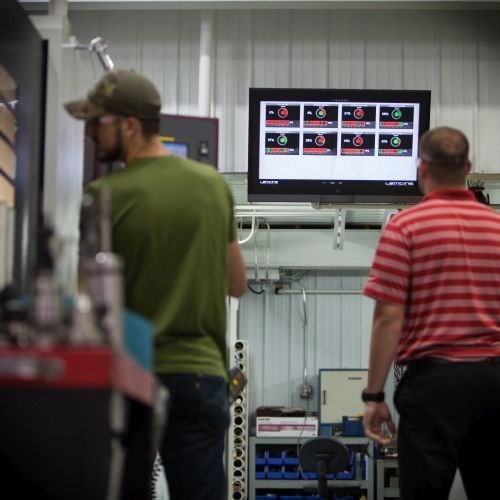10 Ideas for Machine Shops in 2016
What is the next important step for your shop? Drawn from the entire past year of 91ÊÓƵÍøÕ¾ÎÛ, here are 10 possibilities to consider.
Share






Idea #2: Put performance on display. This photo was taken on the shop floor at Byrne Tool + Design. (Photo by .)
What is the next important step for your machining facility? How will you improve your shop’s process or prospects in the coming year?
Based on steps that other machining facilities have taken, and based on ideas we’ve recently explored in MMS, here are 10 possibilities for you to consider:
1. Automate (particularly with a robot).
Say “automation,” and the picture of a robot is probably what comes to mind. Automation is, of course, a much bigger idea than this, and there are different and simpler ways to realize a more automated process than robotic automation. That said, a robot is among the most powerful and versatile automation tools. This year, take another look at automation, and take another look at a robot in particular. Two small makers of motorcycle parts are showing how to achieve flexible responses to surges in demand through robotic automation.
2. Put performance on display.
Let the employees on the shop floor see exactly the same production metrics that the facility’s managers are watching. One way to do this is with a monitor displaying the performance in real time. Just making the metrics public and visible often leads to direct and measurable improvement in those numbers.
3. Rework your shifts.
Coordinating work across three shifts per day can be complex, and the third shift is often incomplete because it is so hard to staff. A variety of benefits can come from replacing the system of three eight-hour shifts in a five-day workweek with two 10-hour shifts in a four-day week.
4. Size up your software.
Inefficient equipment is easy to spot. Inefficiencies resulting from software limitations are harder to notice. Hardest of all to see are the inefficiencies resulting from software that the shop lacks altogether. Many machining facilities have been surprised to discover the value and impact of software improvements, particularly the adoption of ERP.
5. Look to additive manufacturing.
Additive manufacturing has the potential to transform part designs, lead times and supply chains. In metals, the capability is challenging and costly—it might not be time yet for your shop to invest in additive manufacturing. However, it is time to and its emerging promise for the industries you serve.
6. Use a 3D printer.
Once you buy a 3D printer, even a small and relatively inexpensive one, it can be difficult not to use it. The freedom it gives the shop to generate customized, functional objects can provide the answer to many nagging shopfloor problems that previously went unaddressed. That was .
7. Find the waste.
Non-value-added activity is pervasive in manufacturing. Arguably, there are eight major ways that manufacturing processes routinely waste effort and time. Many of the wasteful steps are invisible, because they are an unexamined part of what the shop does routinely. Walk through your shop and your processes specifically looking for these various types of waste.
8. Bring discipline to devices.
The distraction of employees’ personal devices can be a source of inefficiency. The cameras in those devices poses a security risk in the case of sensitive parts. When this shop owner banned shopfloor cellphone use, he saw measurable productivity gains and received some surprising feedback.
9. Identify the challenge that suggests the next advance.
Challenges often arise gradually. It is easy to accept some slowly growing difficulty as just a chronic problem that has become a bit worse over time. But that growing difficulty might be a sea change. A medical component maker provides a useful illustration in identifying challenges and changing practices to adapt.
10. Collaborate.
A group of independent small shops working together can achieve many of the advantages of a large manufacturer. That is what this coalition of shops discovered, an active and mutually beneficial alliance of shops that even includes some competitors.
11. Bonus idea: Keep reading.
All the links within the 10 ideas above connect to articles and resources published in 2015. Make it a regular habit of reading 91ÊÓƵÍøÕ¾ÎÛ throughout the coming year to find more ideas like these. Subscribe here or renew your subscription.
Read Next
AMRs Are Moving Into Manufacturing: 4 Considerations for Implementation
AMRs can provide a flexible, easy-to-use automation platform so long as manufacturers choose a suitable task and prepare their facilities.
Read MoreMachine Shop MBA
Making Chips and 91ÊÓƵÍøÕ¾ÎÛ are teaming up for a new podcast series called Machine Shop MBA—designed to help manufacturers measure their success against the industry’s best. Through the lens of the Top Shops benchmarking program, the series explores the KPIs that set high-performing shops apart, from machine utilization and first-pass yield to employee engagement and revenue per employee.
Read MoreLast Chance! 2025 Top Shops Benchmarking Survey Still Open Through April 30
Don’t miss out! 91ÊÓƵÍøÕ¾ÎÛ's Top Shops Benchmarking Survey is still open — but not for long. This is your last chance to a receive free, customized benchmarking report that includes actionable feedback across several shopfloor and business metrics.
Read More


















